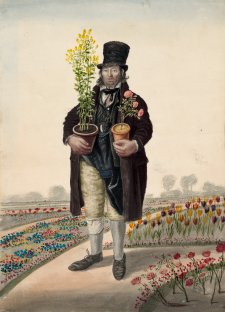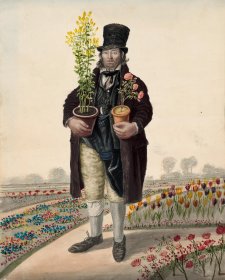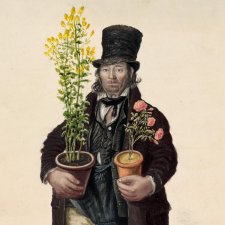- About us
- Support the Gallery
- Venue hire
- Publications
- Research library
- Organisation chart
- Employment
- Contact us
- Make a booking
- Onsite programs
- Online programs
- School visit information
- Learning resources
- Little Darlings
- Professional learning
In the later 18th and early 19th centuries, British politics was dominated by the Tory faction, distant ancestors of today’s Conservative Party. But, in the 1810s, a number of factors contributed to the weakening of the Tories’ position: the economic recession that followed the end of the Napoleonic Wars, and the later collapse of grain prices; the impacts of enclosure and industrialisation, and consequent Luddite unrest; and the agitation for electoral reform and the tragedy of the Peterloo Massacre, where mounted yeomanry killed 11 and injured hundreds at a radical demonstration in Manchester.
In Ipswich, county town of Suffolk, stiffening competition between the Tories (‘True Blues’) and the more progressive Whigs (the Yellow or Buff party) played out not only in parliamentary elections but in the smaller electoral contests of municipal government. After some years of bitter corporation power struggles, the Ipswich Journal lamented in 1826: ‘our town seems fated to be the arena of political contention.’ Indeed, Ipswich seems to have been the model for the ‘ancient, loyal and patriotic Borough’ of Eatanswill, in Dickens’s Pickwick Papers. Dickens writes that the people of the borough,
like the people of many other small towns, considered themselves of the utmost and most mighty importance, and that every man in Eatanswill, conscious of the weight that attached to his example, felt himself bound to unite, heart and soul, with one of the two great parties that divided the town — the Blues and the Buffs. Now the Blues lost no opportunity of opposing the Buffs, and the Buffs lost no opportunity of opposing the Blues; and the consequence was, that whenever the Buffs and Blues met together at public meeting, town-hall, fair, or market, disputes and high words arose between them. With these dissensions it is almost superfluous to say that everything in Eatanswill was made a party question. If the Buffs proposed to new skylight the market-place, the Blues got up public meetings, and denounced the proceeding; if the Blues proposed the erection of an additional pump in the High Street, the Buffs rose as one man and stood aghast at the enormity. There were Blue shops and Buff shops, Blue inns and Buff inns — there was a Blue aisle and a Buff aisle in the very church itself.
So intense was this rivalry and the associated propaganda, lobbying, deal-making, vote-buying and disputed returns, that even the lowest of municipal offices — guide to the hospital, water bailiff and town crier, positions traditionally filled by nominees of the bailiffs — become the subjects of hard-fought battles.
The Tories’ nominee for town crier throughout this period was J. (or T.) Wilkerson (or Wilkinson). Wilkerson had been defeated by the Whigs’ Thomas Grove in 1820 and 1821, but beat him by 13 votes the following year, the Blues having succeeded in taking two of the three lower positions. A contemporary local history notes piously that ‘this election took place on a Sunday; and, though we do not pretend to be very precise, we are confident that it never was contemplated by the granters of the charter, that it was necessary to so strictly abide by the letter of the law, that a contested election for the minor officers of a borough should take place on a day set apart for different purposes’.
Dempsey painted this big-handed portrait of the Tory crier, with its curious formal resonance of top hat and upturned bell, during his East Anglian tour of 1823. It is interesting to note that not only is Wilkerson’s coat the traditional blue, but so are his waistcoat and breeches — in the heightened political atmosphere, this was quite possibly a deliberate advertisement of party loyalty.
The blue bellman did not last long, however. While in 1824 and 1825 the minor corporation offices once again fell to the Whigs, in 1826 it was a near-run thing ‘until about eight in the evening, when a party of London Voters arrived by the Ipswich Steamer, and decided the election in favour of the Yellow Party’, Wilkerson going down to W.H. (Henry) Nunn 256 votes to 331. The Whigs retained control of the corporation — and the crier’s bell — for the rest of the decade.
The intensity of the contest seems out of all proportion to the reward, at least as far as the individual candidates were concerned. The Ipswich crier’s salary was a paltry £6 per annum, with a further £1.11.6 dinner money and £1.3.4 ‘coat money’, and odd special payments such as 12 shillings in September 1824 for ‘Giving Notices Respecting the Water’.
Collection: Tasmanian Museum and Art Gallery, presented by C. Docker, 1956



Dempsey’s people: a folio of British street portraits 1824–1844 is the first exhibition to showcase the compelling watercolour images of English street people made by the itinerant English painter John Dempsey throughout the first half of the nineteenth century.



Visit us, learn with us, support us or work with us! Here’s a range of information about planning your visit, our history and more!



We depend on your support to keep creating our programs, exhibitions, publications and building the amazing portrait collection!